Macroeconomic strategies, agriculture and rural poverty in post ...
Macroeconomic strategies, agriculture and rural poverty in post ...
Macroeconomic strategies, agriculture and rural poverty in post ...
Create successful ePaper yourself
Turn your PDF publications into a flip-book with our unique Google optimized e-Paper software.
enefit well situated farmers; most African producers will cont<strong>in</strong>ue to be relatively<br />
disadvantaged, even after a l<strong>and</strong> reform, by their distance from roads, railways <strong>and</strong> major<br />
markets.” Tea production <strong>in</strong> the former Transkei is one <strong>in</strong>dustry which will almost certa<strong>in</strong>ly<br />
do worse under a freer trad<strong>in</strong>g regime (Porter <strong>and</strong> Phillips-Howard 1996). Before GATT, a<br />
quota system protected producers by from cheaper imports; while contractors sold tea at<br />
between R12 <strong>and</strong> R14 per kilo, it was possible to import high quality tea for R8 per<br />
kilogramme. Porter <strong>and</strong> Phillips-Howard (1996) argue that tea production - <strong>and</strong> livelihoods<br />
<strong>and</strong> employment - <strong>in</strong> this region is extremely vulnerable to a more open trad<strong>in</strong>g regime. Gear<br />
places a large burden of responsibility <strong>in</strong> <strong>poverty</strong> alleviation on small scale farmers; whether<br />
small scale farmers will be able to grow to deliver on these high expectations <strong>in</strong> a neo-liberal<br />
<strong>and</strong> open macroeconomy is very much <strong>in</strong> doubt.<br />
De Janvry et al’s (1995) research on Mexico <strong>and</strong> the diversification of small scale farmers<br />
<strong>in</strong>to high value foods raises the question of the possibility of emerg<strong>in</strong>g farmers <strong>in</strong> South<br />
Africa participat<strong>in</strong>g <strong>in</strong> the export of fruit, citrus <strong>and</strong> grape products. Citrus <strong>and</strong> fruit<br />
production is economically viable on very small tracts of l<strong>and</strong> <strong>and</strong> the large fruit market<strong>in</strong>g<br />
organisations - Outspan <strong>and</strong> Unifruco - are <strong>in</strong>volved <strong>in</strong> assist<strong>in</strong>g small farmers produc<strong>in</strong>g the<br />
high quality fruit that is required for export. In the citrus <strong>in</strong>dustry, most of the oranges <strong>and</strong><br />
grapefruit produced by black farmers orig<strong>in</strong>ates from former bantustan development<br />
schemes which have been transformed to allow <strong>in</strong>dividual control <strong>and</strong> cultivation of crops.<br />
Although <strong>in</strong>comes vary widely, on one scheme <strong>in</strong> the Northern Prov<strong>in</strong>ce some farmers are<br />
earn<strong>in</strong>g upwards of R100,000 per year, an enormous sum compared to average <strong>rural</strong> <strong>in</strong>comes<br />
<strong>in</strong> South Africa. The apparent success of schemes like these must be set aga<strong>in</strong>st the<br />
enormous costs of establish<strong>in</strong>g small scale fruit farm<strong>in</strong>g schemes. Establish<strong>in</strong>g citrus - which<br />
<strong>in</strong>volves prepar<strong>in</strong>g the l<strong>and</strong>, purchas<strong>in</strong>g trees <strong>and</strong> construct<strong>in</strong>g the <strong>in</strong>frastructure for irrigation<br />
- is over R14,000 per hectare. This figure does not take <strong>in</strong>to consideration the <strong>in</strong>creas<strong>in</strong>gly<br />
high cost of l<strong>and</strong> with access to water (van der Riet <strong>and</strong> Darroch 1993). Returns on<br />
<strong>in</strong>vestment are typically only realised after five years <strong>and</strong> profits are earned only after 7 to 8<br />
depend<strong>in</strong>g on the proportion of the crop exported. The considerable costs of establish<strong>in</strong>g a<br />
fruit farm expla<strong>in</strong>s why Outspan is prepared to assist emerg<strong>in</strong>g farmers on former bantustan<br />
schemes where the <strong>in</strong>frastructure for irrigation farm<strong>in</strong>g is already <strong>in</strong> place. The result is that<br />
there are probably less than 100 citrus small scale black citrus farmers <strong>in</strong> the country. Large<br />
establishment costs also account for the current <strong>in</strong>terest <strong>in</strong> equity schemes as a way of<br />
empower<strong>in</strong>g <strong>rural</strong> workers <strong>in</strong> high value export <strong>agriculture</strong>. The obstacles to small farmers <strong>in</strong><br />
high value food exports is also apparent <strong>in</strong> other contexts. In Chile, where the<br />
transformation of farm<strong>in</strong>g towards exports has been extremely successful, l<strong>and</strong> concentration<br />
has occurred <strong>and</strong> smallholders have been marg<strong>in</strong>alised from the benefits of the export boom<br />
(Jaffee 1993).<br />
F<strong>in</strong>ally, Gear’s emphasis on small scale farm<strong>in</strong>g must be set aga<strong>in</strong>st its potential for<br />
alleviat<strong>in</strong>g <strong>and</strong> eradicat<strong>in</strong>g <strong>rural</strong> <strong>poverty</strong>. There are two issues which suggest that emerg<strong>in</strong>g<br />
farmers cannot be the only solution to <strong>rural</strong> <strong>poverty</strong>. The first was referred to earlier <strong>in</strong> the<br />
paper: recent <strong>poverty</strong> studies <strong>in</strong>dicate that <strong>rural</strong> Africans who are able to earn an <strong>in</strong>come<br />
from <strong>agriculture</strong> also earn wages <strong>in</strong> the primary labour market. The poorest <strong>rural</strong> households,<br />
<strong>in</strong> contrast, are unable to earn any <strong>in</strong>come whatsoever from <strong>agriculture</strong> <strong>and</strong> use what is<br />
produced on the l<strong>and</strong> for personal consumption. A <strong>rural</strong> l<strong>and</strong> reform programme that is<br />
aimed at <strong>in</strong>creas<strong>in</strong>g the efficiency of ‘emerg<strong>in</strong>g farmers’ is unlikely to reach the poorest<br />
households <strong>and</strong> is much more likely to assist farmers who are already earn<strong>in</strong>g part of their<br />
<strong>in</strong>come from farm<strong>in</strong>g. In other words, a small scale farm<strong>in</strong>g campaign is less likely to assist<br />
the poorest <strong>rural</strong> households <strong>and</strong> will probably <strong>in</strong>crease <strong>rural</strong> differentiation. The second<br />
issue is that even if a small farmer scheme were successful <strong>in</strong> target<strong>in</strong>g the <strong>rural</strong> poor, it is<br />
doubtful that enough farmers could be targeted to have a mean<strong>in</strong>gful impact on <strong>rural</strong><br />
15

















